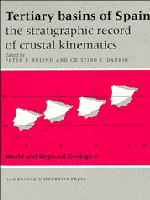Book contents
- Frontmatter
- Contents
- List of contributors
- Preface
- Dedication to Professor Oriol Riba IArderiu
- Memorial, Etienne Moissenet 1941–1994
- PART G GENERAL
- PART E EAST
- PART W WEST
- W1 The Duero Basin: a general overview
- W2 Alpine tectonic framework of south-western Duero basin
- W3 South-western Duero and Ciudad Rodrigo basins: infill and dissection of a Tertiary basin
- W4 Tectono-sedimentary evolution of the Almazán Basin, NE Spain
- W5 Tertiary basins and Alpine tectonics in the Cantabrian Mountains (NW Spain)
- W6 Lacustrine Neogene systems of the Duero Basin: evolution and controls
- W7 North-western Cainozoic record: present knowledge and the correlation problem
- W8 Onshore Cenozoic strike–slip basins in NW Spain
- W9 Tertiary of Central System basins
- PART C CENTRE
- PART S SOUTH
- Index
W6 - Lacustrine Neogene systems of the Duero Basin: evolution and controls
Published online by Cambridge University Press: 04 August 2010
- Frontmatter
- Contents
- List of contributors
- Preface
- Dedication to Professor Oriol Riba IArderiu
- Memorial, Etienne Moissenet 1941–1994
- PART G GENERAL
- PART E EAST
- PART W WEST
- W1 The Duero Basin: a general overview
- W2 Alpine tectonic framework of south-western Duero basin
- W3 South-western Duero and Ciudad Rodrigo basins: infill and dissection of a Tertiary basin
- W4 Tectono-sedimentary evolution of the Almazán Basin, NE Spain
- W5 Tertiary basins and Alpine tectonics in the Cantabrian Mountains (NW Spain)
- W6 Lacustrine Neogene systems of the Duero Basin: evolution and controls
- W7 North-western Cainozoic record: present knowledge and the correlation problem
- W8 Onshore Cenozoic strike–slip basins in NW Spain
- W9 Tertiary of Central System basins
- PART C CENTRE
- PART S SOUTH
- Index
Summary
Abstract
Vertical aggradation of Neogene fluvial and lacustrine deposits occurred until the Late Neogene in central and northern areas of the Duero Basin, coeval with river incision in the southwestern corner of the basin. The whole basin became exorheic in the Latest Neogene. We have differentiated five tectonosedimentary units (TSUs) of basinal extent, bounded by unconformities or breaks in the sedimentary record. Deposits in each TSU consist of alluvial-fan deposits in areas close to the active northern and eastern margins, and fluvial deposits along the western margin. These systems converged in the lower, subsiding areas of the basin occupied by carbonate-evaporite lacustrine systems.
Tectonics and climate controlled sedimentation. The main faults active from the Neogene to the Present reflect Late Hercynian basement fractures that were re-activated during the Alpine Orogeny, both fracturing blocks and modifying landscapes, and creating or modifying the areas of subsidence. Analysis of climatic variations during the Miocene shows that deposition of saline materials occurred in dry TSUs (1,2) and, particularly, in humid TSUs (3, 4). Climate does not seem to have been a determining factor for the formation of evaporites. However, it was a very important factor in determining both the amount of water that reached the basin and, eventually, also the extent of the lacustrine systems.
- Type
- Chapter
- Information
- Tertiary Basins of SpainThe Stratigraphic Record of Crustal Kinematics, pp. 228 - 236Publisher: Cambridge University PressPrint publication year: 1996
- 9
- Cited by



